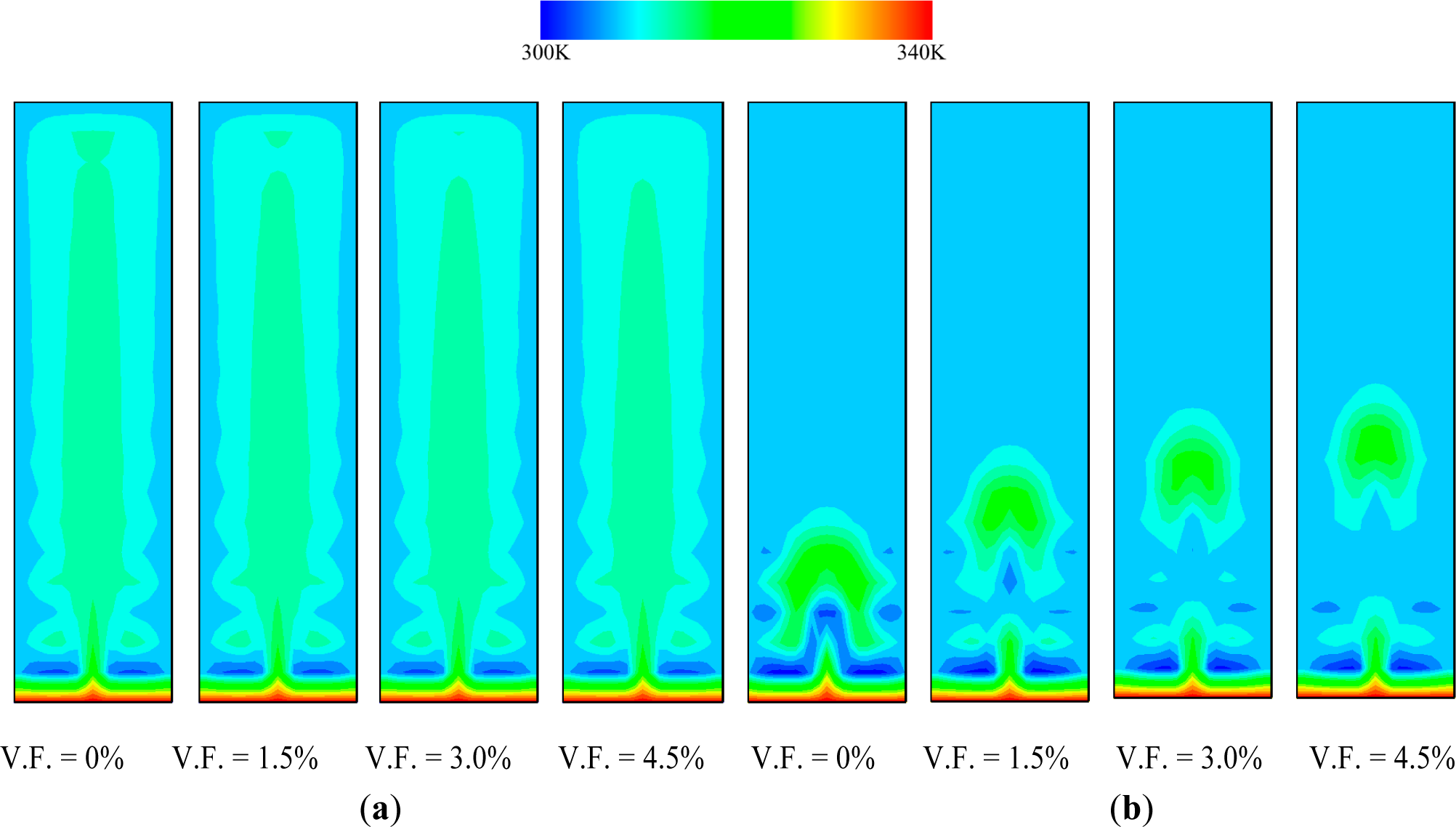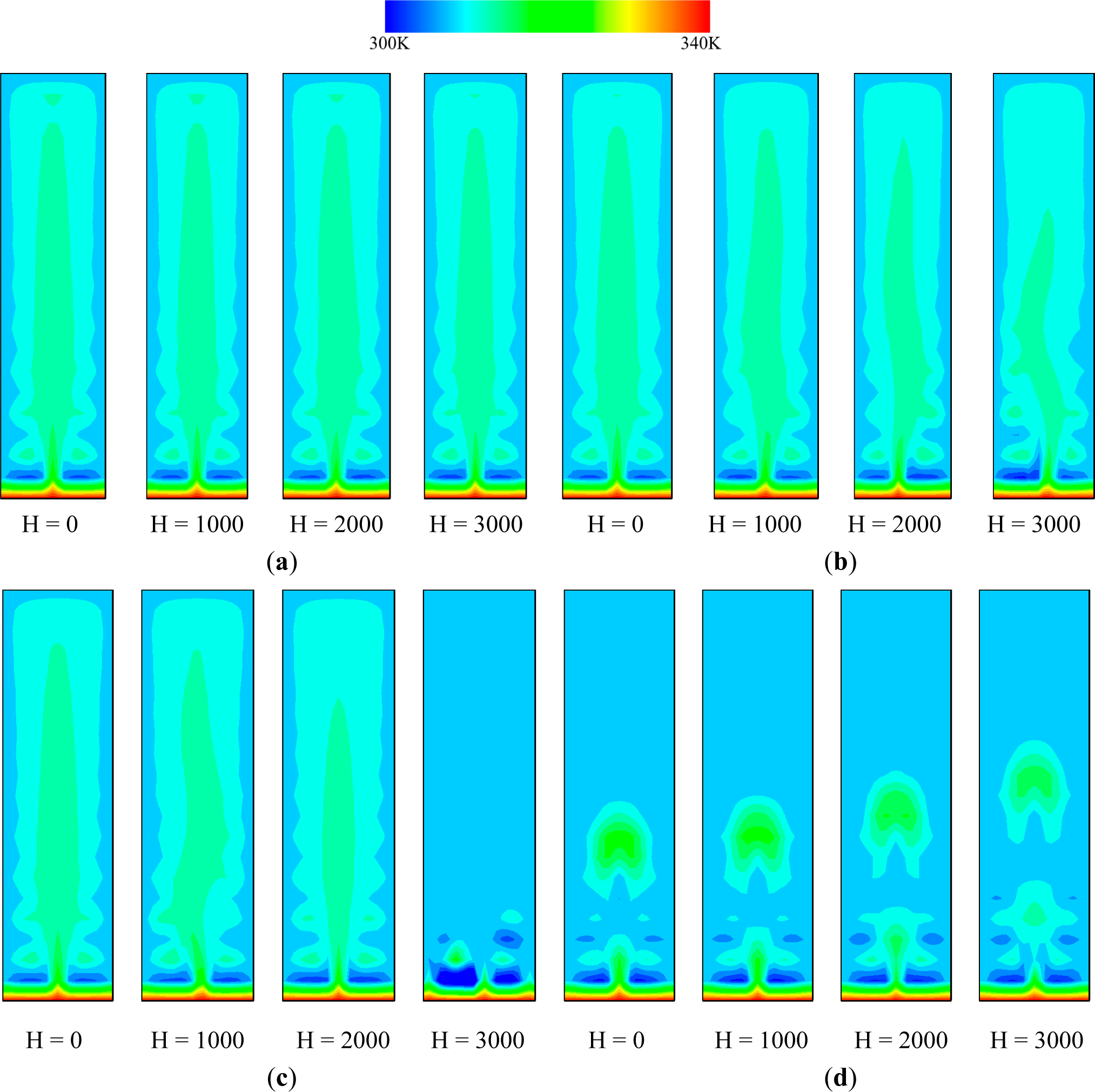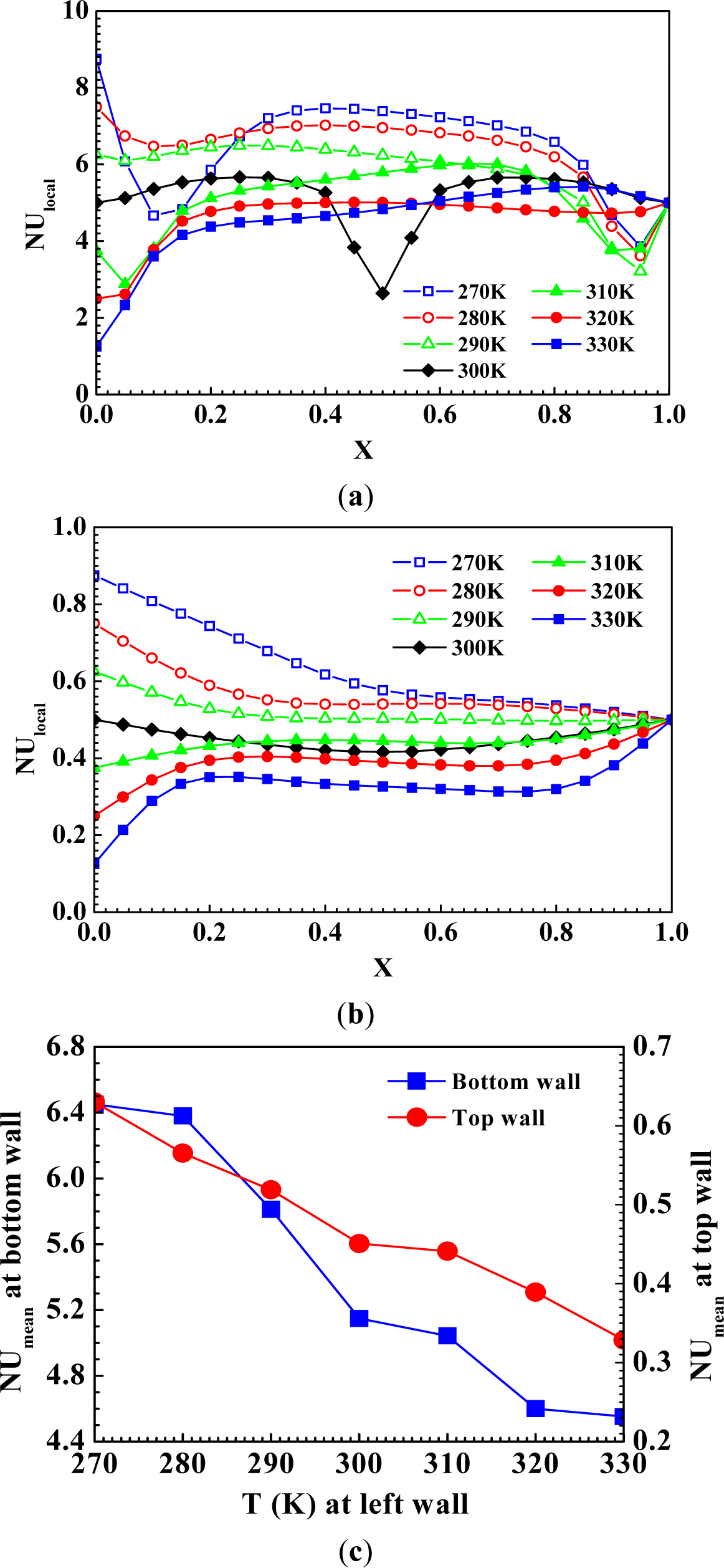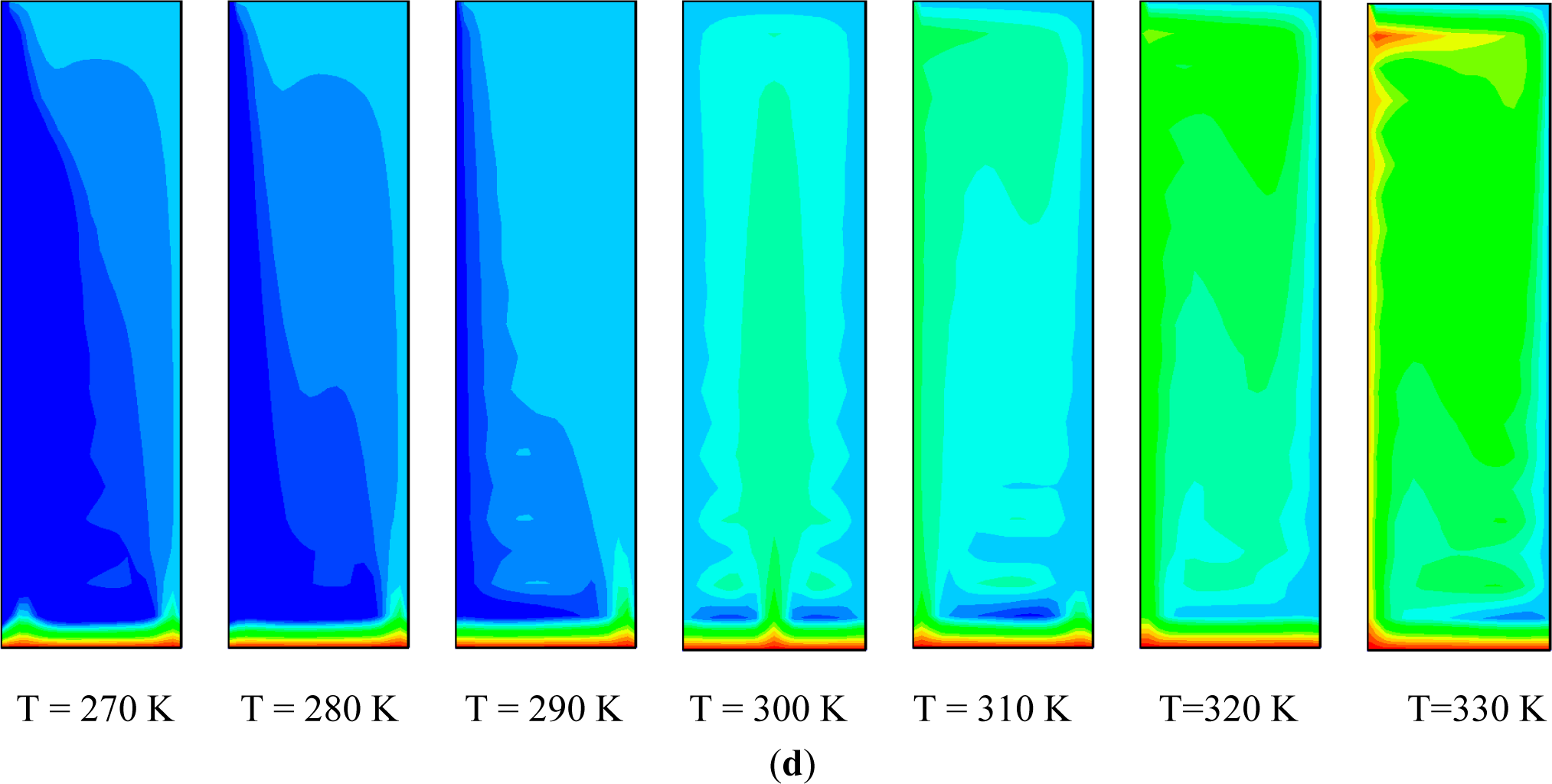Thermophysical Characteristics of the Ferrofluid in a Vertical Rectangle
Abstract
:1. Introduction
2. Numerical Method
3. Results and Discussion
3.1. Thermal-Flow Characteristics
3.2. Nusselt Numbers and Heat Transfer Characteristics
4. Conclusions
Acknowledgments
Author Contributions
Conflicts of Interest
References
- Horng, H.E.; Hong, C.Y.; Yang, S.Y.; Yang, H.C. Novel properties and applications in magnetic fluids. J. Phys. Chem. Solids 2001, 62, 1749–1764. [Google Scholar]
- Jin, L.; Zhang, X.; Niu, X. Lattice Boltzmann simulation for temperature-sensitive magnetic fluids in a porous square cavity. J. Magn. Magn. Mater 2012, 324, 44–51. [Google Scholar]
- Zhao, Y.; Zhang, Y.; Lv, R.; Wang, Q. Novel optical devices based on the tunable refractive index of magnetic fluid and their characteristics. J. Magn. Magn. Mater 2011, 323, 2987–2996. [Google Scholar]
- Torii, S. Experimental study on thermal transport phenomenon of nanofluids as working fluid in heat exchanger. Int. J. Air Cond. Refrig 2014, 22, 1450005. [Google Scholar]
- Yun, R.; Hwang, Y. Inflow condensation heat transfer characteristics of CO2 in microchannel. Int. J. Air Cond. Refrig 2014, 22, 1450011. [Google Scholar]
- Jang, D.S.; Lee, E.J.; Lee, S.H.; Kim, Y.C. Thermal Performance of Flat Plate Pulsating Heat Pipes with Mini- and Micro-Channels. Int. J. Air Cond. Refrig 2014, 22, 1450025. [Google Scholar]
- Cho, H.G.; Kim, T.H.; Kim, J.H.; Lee, C.S.; Choi, J.H. Simulation Results for the Effect of Fin Geometry on the Performance of a Concentric Heat Exchanger. Int. J. Air Cond. Refrig 2014, 22, 1450026. [Google Scholar]
- Sheikholeslami, M.; Ellahi, R.; Hassan, M.; Soleimani, S. A study of natural convection heat transfer in a nanofluid filled enclosure with elliptic inner cylinder. Int. J. Numer. Methods Heat Fluid Flow 2014, 24, 1906–1927. [Google Scholar]
- Akbar, N.S.; Raza, M.; Ellahi, R. Interaction of nano particles for the peristaltic flow in an asymmetric channel with the induced magnetic field. Eur. Phys. J. Plus 2014, 129, 1–12. [Google Scholar]
- Ellahi, R. The effects of MHD and temperature dependent viscosity on the flow of non-Newtonian nanofluid in a pipe: Analytical solutions. Appl. Math. Model 2013, 37, 1451–1467. [Google Scholar]
- Kim, S.C.; Seo, J.H.; Lee, D.Y.; Hong, D.P.; Kang, S.J.; Lee, M.Y. Thermodynamic behaviors of magnetic-fluid in a thin channel with magnetic field and aspect ratio. Int. J. Precis. Eng. Manuf 2014, 15, 1377–1382. [Google Scholar]
- Lee, M.Y.; Seo, J.H. Numerical investigation on heat and flow characteristics of temperature-sensitive ferrofluid in a square cavity. Adv. Mech. Eng 2013, 2013, 240438. [Google Scholar]
- Wang, Q.W.; Zeng, M.; Huang, Z.P.; Wang, G.; Ozoe, H. Numerical investigation of natural convection in an inclined enclosure filled with porous medium under magnetic field. Int. J. Heat Mass Transfer 2007, 50, 3684–3689. [Google Scholar]
- Hollands, K.G.T.; Unny, T.E.; Raithby, G.D.; Konicek, L. Free convective heat transfer across inclined air layers. J. Heat Transfer 1976, 98, 189–193. [Google Scholar]
- Ferrotec Corporation. Available online: http://www.ferrotec.com/ accessed on 5 January 2014.
- Sawada, T.; Kikura, H.; Tanahashi, T. Visualization of wall temperature distribution caused by natural convection of magnetic fluids in a cubic enclosure. Int. J. Appl. Electromagn. Mater 1994, 4, 329–335. [Google Scholar]
- Park, J.W. A Study on the Heat Transfer Characteristics and Fluid Flow of Magnetic Fluids in Concentric Double Pipe Annuli. Ph.D. Thesis, Dong-A University, Busan, Korea, 2002. [Google Scholar]
- Seo, J.H.; Lee, M.Y. Numerical analysis on thermal-fluidic characteristics of the magnetic fluid in a cavity using GSMAC. J. Korea Acad. Ind. Coop. Soc 2013, 14, 997–1002. [Google Scholar]
- Seo, J.H.; Lee, M.Y.; Seo, L.S. Study of natural convection of magnetic fluid in cubic cavity. Trans. Korean Soc. Mech. Eng. B 2013, 37, 637–646. [Google Scholar]
- Odenbach, S.; Liu, M. Invalidation of the Kelvin force in ferrofluids. Phys. Rev. Lett 2001, 86, 328–331. [Google Scholar]
- Seo, J.H.; Kim, D.W.; Lee, M.Y. Heat transfer characteristics of the magnetic fluid in the inclined rectangular cavity using finite element method, Proceedings of the International Conference of Saving Energy in Refrigeration and Air-Conditioning, Yeosu, Korea, 23–25 October 2013; pp. 77–80.
- Grosan, T.; Revnic, C.; Pop, I.; Ingham, D.B. Magnetic field and internal heat generation effects on the free convection in a rectangular cavity filled with a porous medium. Int. J. Heat Mass Transfer 2009, 52, 1525–1533. [Google Scholar]
- Lajvardi, M.; Moghimi-Rad, J.; Hadi, I.; Gavili, A.; Isfahani, T.D.; Zabihi, F.; Sabbaghzadeh, J. Experimental investigation for enhanced ferrofluid heat transfer under magnetic field effect. J. Magn. Magn. Mater 2010, 322, 3508–3513. [Google Scholar]






| Properties | Conditions |
|---|---|
| Magnetic field intensities (A/m) | 0, 1000, 2000, 3000 (Normal) |
| Temperature of the left wall, T2, T4 (K) | 270, 280, 290, 300 (Normal), 310, 320 |
| Temperature of the left wall, T1 (K) | 340 (Normal) |
| Temperature of the left wall, T3 (K) | 300 (Normal) |
| Properties | Water | FF1 | FF2 | FF3 |
|---|---|---|---|---|
| Volume fraction of magnetite (%) | 0 | 1.5 | 3.0 | 4.5 |
| Nominal particle diameter (nm) | – | 10 | 10 | 10 |
| Density at 298 K (kg/m3) | 946.9 | 1044 | 1142 | 1240 |
| Viscosity at 300 K (mPa·s) | 0.854 | 1.9 | 2.95 | 4.0 |
| Saturation magnetization (mT) | – | 9.2 | 18.3 | 27.5 |
| Prandtl number | 6.1 | 13.2 | 20.3 | 27.4 |
© 2015 by the authors; licensee MDPI, Basel, Switzerland This article is an open access article distributed under the terms and conditions of the Creative Commons Attribution license (http://creativecommons.org/licenses/by/4.0/).
Share and Cite
Seo, J.-H.; You, B.-H.; Kwen, S.-S.; Lee, D.-Y.; Lee, M.-Y. Thermophysical Characteristics of the Ferrofluid in a Vertical Rectangle. Entropy 2015, 17, 903-913. https://doi.org/10.3390/e17020903
Seo J-H, You B-H, Kwen S-S, Lee D-Y, Lee M-Y. Thermophysical Characteristics of the Ferrofluid in a Vertical Rectangle. Entropy. 2015; 17(2):903-913. https://doi.org/10.3390/e17020903
Chicago/Turabian StyleSeo, Jae-Hyeong, Byoung-Hee You, Sang-Seuk Kwen, Dong-Yeon Lee, and Moo-Yeon Lee. 2015. "Thermophysical Characteristics of the Ferrofluid in a Vertical Rectangle" Entropy 17, no. 2: 903-913. https://doi.org/10.3390/e17020903
APA StyleSeo, J.-H., You, B.-H., Kwen, S.-S., Lee, D.-Y., & Lee, M.-Y. (2015). Thermophysical Characteristics of the Ferrofluid in a Vertical Rectangle. Entropy, 17(2), 903-913. https://doi.org/10.3390/e17020903






